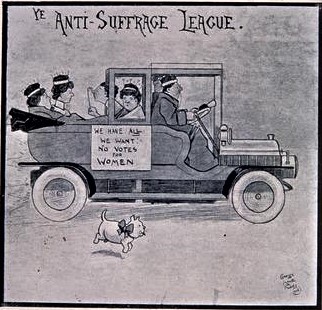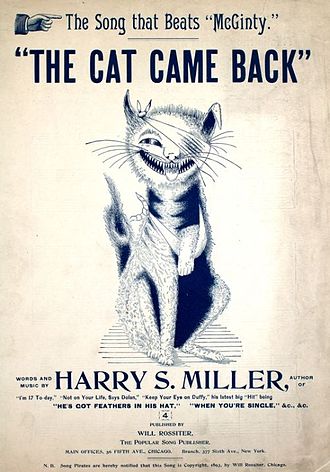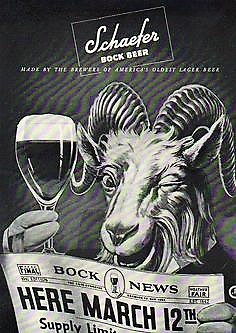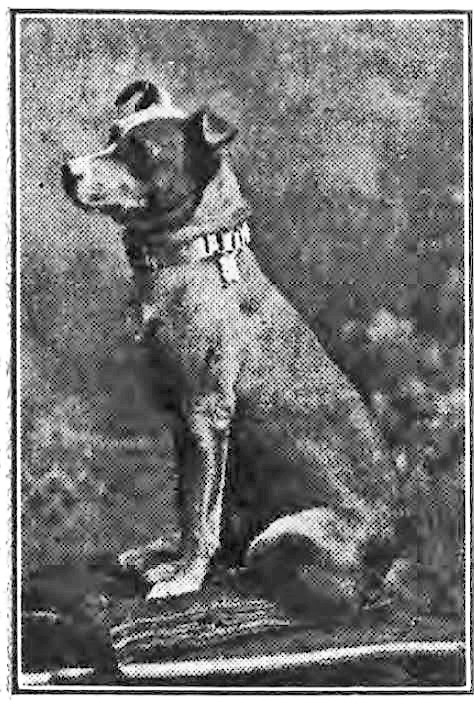
For 13 years, Roxie the Long Island Railroad Dog rode the trains across Long Island whenever he pleased. He never missed a connection, and always arrived at his intended destination. Only once did he choose the wrong train and end up in unfamiliar territory.
One day in April 1911, Roxy (aka Roxie) the Long Island Railroad (LIRR) dog got on the wrong train at Manhattan’s Penn Station and ended up in Philadelphia. For 10 years, Roxy had never made such a mistake while riding the trains across Long Island. Roxy’s hundreds of fans were no doubt surprised to read about his adventure in the newspapers the next day.
I have a feeling that this was the first time Roxy had ever been to Manhattan, and thus, like many tourists visiting the city for the first time, he simply got confused and overwhelmed.
Roxy arrived at the LIRR in 1901, just one year after the Pennsylvania Railroad had paid $6 million for a controlling interest in the LIRR. The two railroad companies had been incorporated to build the New York Tunnel Extension from New Jersey through Manhattan to Long Island City in Queens.
The project would include a new railroad station in Manhattan and a new rail yard (Sunnyside Yards) at Long Island City to provide a place for the New Jersey trains to turn around. The new station and tunnel network provided direct rail service for passengers traveling between Long Island and Manhattan.
Ten years later, in September 1910, Pennsylvania Station began serving only the LIRR trains while the New Jersey side of the tunnel was completed. The station was fully opened to the public on November 27, 1910.
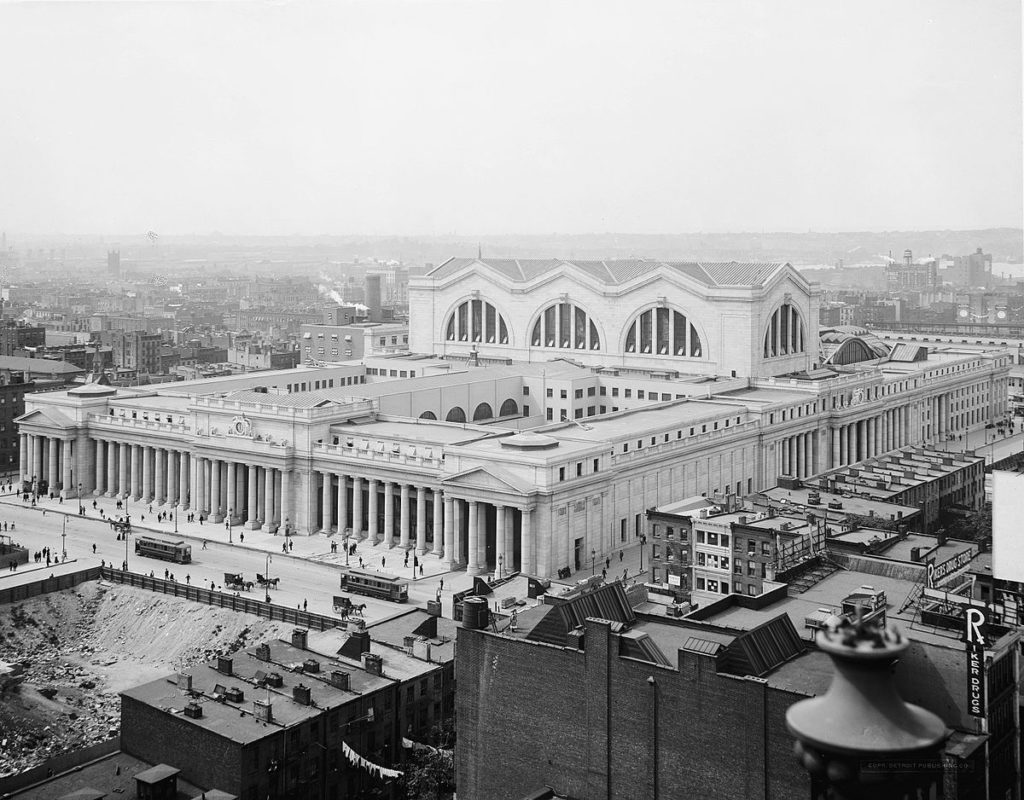
Designed by McKim, Mead, and White and completed in 1910, the original Pennsylvania Station occupied two city blocks from Seventh Avenue to Eighth Avenue and from 31st to 33rd Streets. Although it was considered a masterpiece of the Beaux-Arts style and one of the architectural jewels of New York City, the above-ground portion of the building was demolished in 1963. Look at the size of this building — it’s no wonder Roxy got lost and boarded the wrong train!
When Roxy took his first train to Penn Station in April 1911, he was traveling with his favorite commuter companion during that time, a traveling salesman from Brooklyn named Roy Budd. (Roxy had a lot of different favorite commuters over the years.) As the story goes, when the train arrived at the Broad Street Station, he ran down the platform, wheeled around a few times, let out some whelps, and sniffed out a train on its way back to New York.
Roxy reportedly made it back to the Jamaica station in Queens with an hour to spare before the Amagansett Express train from Moutauk Point arrived. When it arrived, Phil Norrie, the engine driver, presented Roxy with his weekly seafood dinner from Montauk Point. After the big meal, as he did every Thursday evening, Roxy spent the night in Jamaica with station master Martin Wilteo.
“An Ornery Yallow Dog”
There are several stories about Roxy and how he first arrived at the LIRR yards. One news article said he met Mrs. Ellphat Willetts of Roslyn, Long Island, in August 1901 at the corner of First Avenue and 34th Street. He followed her to the Long Island Ferry and boarded with her. At the train station, Mrs. Willetts instructed the baggage man to put the dog off in Roslyn, as she intended to adopt him. Roxy instead jumped off in Floral Park, where he met a LIRR conductor named Mr. Caldwell.
According to another published report, Roxy showed up at the LIRR yards in Long Island City on a dreary December day in 1901. He was “a dilapidated specimen of the canine species, which could not be described as belonging to any particular breed.” As conductor Doc Rogers noted, he was “an ornery yallow dog.”
However, his sad condition aroused the sympathy of Mr. Keenan, the railroad agent at Garden City, and so he took the little dog home. After a short time the dog developed a decided liking for railroad men, baggage cars, cabooses, locomotives, coaches and anything that had to do with the railroad. He especially loved any man wearing a LIRR uniform.

Roxy’s home station was the Long Island Railroad yards in Long Island City, pictured here on the right in 1938, just before the Queens Midtown Tunnel was constructed. All the tenements in this photo were demolished to make way for the tunnel; the sunken plaza and mouth of the tunnel are right about at the foreground of this photo. New York Public Library Digital Collections
Roxy became a great pet with the railroad crews, and was taught many tricks by them. He spent his days wandering Long Island by train, and his nights in Garden City with Mr. Keenan. The passengers called him “the commuter,” but he would never respond to anything but Roxy.
Over the years, as Roxy made friends with more railroad men and a few lucky commuters, he spent his nights at various locations, depending on his mood. One of his favorite rest places was the Long Island Railroad branch of the Y.M.C.A., which had a building at 45 Borden Avenue, across from the rail yards.
The LIRR Branch of the Y.M.C.A.
Founded in London in 1844, the Young Men’s Christian Association began its labors in the United States in 1872 among railroad men in Cleveland, Ohio. Reportedly, an employee who had been discharged for drunkenness but who subsequently reformed and engaged in active Christian service invited a minister to preach to railroad men in the waiting room of the station. Crowds of people attended and a revival broke out among the men, giving rise to the first branch of the YMCA composed of railroad men.

A new five-story Y.M.C.A. for the men of the LIRR was constructed on the northeast corner of Borden Avenue and West Avenue (today’s 5th Street) in 1908. Roxy spent many evenings here between 1901 and 1913, and was elected to full lifetime membership without dues.
In 1875, the Cleveland railroad men visited New York–and in particular, the Vanderbilt family–to show the city what they had done to provide housing and support for the men working in the railroad industry. As the men pointed out, the Y.M.C.A. provided clean overnight accommodations, affordable meals, and an array of programs to keep them occupied and out of trouble in between journeys.
One of the first railroad branches of the YMCA in New York City was housed in the basement of the New York Rail Station on the site of the present-day Grand Central Terminal. Twenty years later, on March 1, 1894, a branch for the LIRR men was established at 45 Borden Avenue in Long Island City. Although this building was demolished in a fire in 1895, it was soon thereafter replaced by a three-story structure on the same site.
In 1908, Margaret Olivia Slocum Sage donated $100,000 for the construction of a new, five-story Y.M.C.A. to replace the older three-story structure on the corner of Borden Avenue and West Avenue (today’s 5th Street). Margaret was the wife of Russell Sage, a famous financier, railroad executive, and robber baron, who had amassed a fortune in the railroad industry. When he died in 1906, she became a benefactor to an array of charities, from educational and religious to medical and cultural.
Designed by John W. Ingle and built by Edward Corning Co., the building was constructed of North River brick and Indiana limestone. Due to its proximity to the East River, it was built on piles and the entire site was waterproofed.
On April 30, 1908, LIRR President Ralph Peters laid the cornerstone for the new Y.M.C.A. A copper box was placed inside the cornerstone, which included a card from President Teddy Roosevelt and a card from George B. Cortelyou, Secretary of the Treasury; a list of members of the LIRR YMCA; a copy of the agreement between Mrs. Sage and the LIRR Company; the 54th Annual Report of the Brooklyn Y.M.C.A.; the 26th Annual Report of the LIRR Company; a silver quarter from 1908; a Y.M.C.A. passbook containing the first membership card when the branch was organized March 1, 1894; and more.
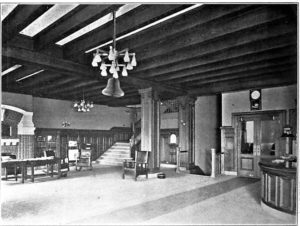
The Y.M.C.A. featured a library, cafeteria, gymnasium, dormitories for the men, and many other amenities. It was also a great bachelor pad for Roxy when he wasn’t train hopping.
Lifetime Railroad Pass
For a dozen years, Roxy enjoyed all the privileges of a railroad pass that was accepted on all of the branches of the LIRR. Almost every day he would travel by train, always getting one of the best seats and a cordial welcome.
The conductor would say, “President Peter’s orders are that Roxy has the privilege to occupy a seat in any car at any time.”
Sometimes he’d sit with the passengers, while other days he preferred riding in the baggage car or with the fireman. He was known to spring from the open cab while the train was going 40 miles an hour. But he could also sit patiently still on the platform while waiting for just the right train to bring him back to Jamaica or Long Island City.
On several occasions, Roxy traveled in a private car with President Roosevelt to Oyster Bay. Sometimes he’d visit the president’s home there. The Roosevelt children reportedly loved him.
We also know that he spent the Easter holidays in Merrick in 1905. Whomever he stayed with put a blue ribbon on his collar that read, “I spent Easter at Merrick and had a daisy time.” Perhaps this was Miss Elsie Hess, a school teacher who lived across the street from the Merrick station. Miss Hess always gave Roxy a drumstick at Christmas, and he’d also go to her house for care whenever he was ill. She even had a wicker basket just for him in case he stayed the night.

Roxy spent his days riding the trains of the LIRR, like this circa 1911 electric coach. Somehow he always knew which train to take to get to his desired destination. I wonder if Roxy ever took this specific train?
In the early years, Roxy would only follow railroad employees. But in his senior years he switched his loyalty to passengers. First their was Mr. Warren of Jamaica, and then there was Roy Budd, who led him to Penn Station on that fateful day Roxy boarded the wrong train. Roxy not only followed Roy on and off the trains, but he also rode in automobiles with him, dined at hotels, slept in the same room, and stayed with him for an entire week.
For most of his lifetime, Roxy was not required to wear any type of license or tag. Perhaps it was because he claimed a legal residence in Suffolk County, which didn’t have the same rules as Manhattan had regarding dogs. However, in 1912 he was tagged and numbered like any other dog, and registered as dog #191175 by the SPCA.
His license was attached to his special collar, which Nelson Jones, secretary of the LIRR branch of the Y.M.C.A., had presented to him in 1903. The collar had an engraved plate that read: I’m Roxie, the Long Island Railroad Dog. Whose Dog Are You?
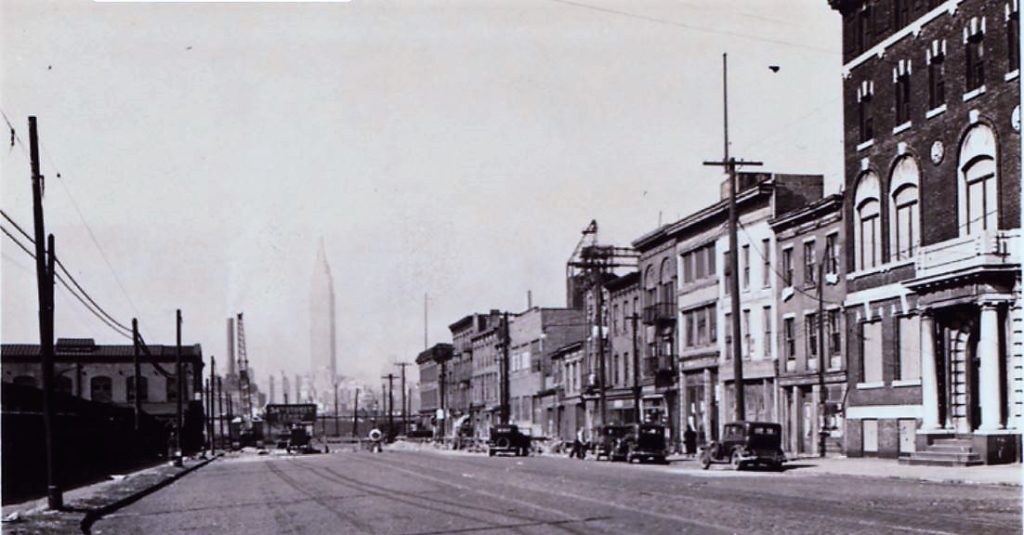
In this photo of Borden Avenue taken in 1934, the Y.M.C.A. building on the right looks all boarded up. Construction on the Midtown Tunnel began in 1936, and by 1939, all of these buildings had been demolished. Today, the ventilation building for the tunnel stands on this site. NYPL Digital Collections
The Dog With Nine Lives
Roxy had his share of accidents over the years, but he always received good care from the best veterinarians. In fact, Roxy had his very own bank account (about $300) at the Corn Exchange Bank in Long Island City to help pay for any care he needed.
In June 1902, he was run over by a car on Borden Avenue and treated by Dr. Edward N. Leavy in Hempstead. (The Brooklyn Daily Eagle reported that the railroad “would like very much to interview in a physical manner the chauffeur who purposely ran down their canine pet.”) And In 1905, a man threw a stone at Roxy in Hempstead, fracturing his fore leg. Roxy was tended to by a Dr. Crundell and had to wear a stint for several weeks.
By the end of 1913, Roxy’s gypsy life had taken a toll on him. Although Dr. W.L. Johnson had succeeded in partially healing the dog, he died of dropsy (edema) on June 11, 1914, at the doctor’s home at 76 van Wyck Avenue, Jamaica.
“Railroad Roxle is to he burled to-day and every man on the Long Island Railroad is mourning the loss of its pet and mascot for almost fifteen years. There is to be a pine coffin for Roxie and a funeral service, with two of the company’s representatives to act as pallbearers. A wreath of fresh flowers will be laid on the little pine box. A suitable monument to be designed by Richard Homeyer of Queens…will mark the spot where Roxie is sleeping his last long sleep.”—New York Herald, June 12, 1914
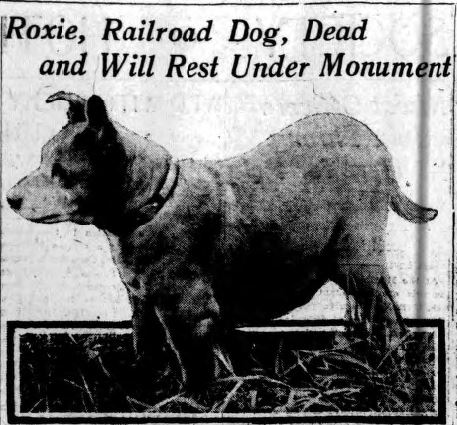
Roxy’s death in 1914 made the headlines of many newspapers in New York State and throughout the country.
Roxy was carried to Merrick in an automobile (you would think a train would have been more appropriate), where Ralph Peters had given permission to Miss Hess to have the pet buried on railroad property adjoining the train station. One of the pall bearers was Roxy’s favorite railroad friend, C.F. Young, foreman of the electric department. The other pall bearer was A.S Slack, foreman of the high tension department.
It wasn’t until 20 years later, during a ceremony in June 1934, that a proper monument was erected on the grave site. According to reports, Mrs. C.U. Shreve, treasurer of the Southside Animal league, was inspired to get the monument after reading a poem about the passing of Miss Hess.
Rev. John Gerstenberg of the Church of the Redeemer opened the ceremony and concluded by reading “A Prayer for a Dog.” A small beagle who had been standing by the grave stepped up to the monument and drank from the fountain. As one newspaper reported, is was a “significant and fitting climax, a justification for those who have labored that Roxy might not be forgotten and that in perpetuating his memory, comfort and joy might be brought to the birds and small animals who chance that way.”
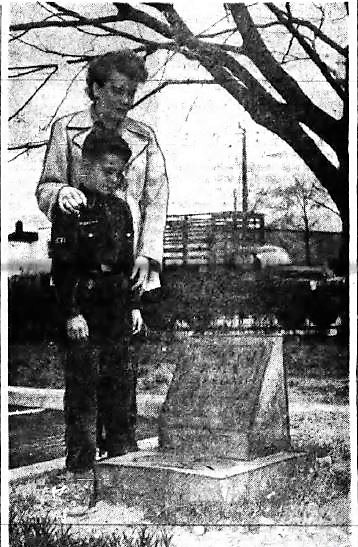
In 1952, workmen tore up everything to build a new Merrick parking field, but they left the grave of Roxy untouched.
In 1951, when the Hempstead Town Board voted to build a parking field running from Merrick to Hewlett Avenues, the question of Roxy’s grave came up. The town fathers acceded to the requests of dog-lovers and old-timers who begged that the grave remain undisturbed.
Back in those days, the highway was still a two-lane road and the train tracks were at grade level. Today, the now-elevated railroad and widened highway leave Roxy’s grave out of sight and almost forgotten, tucked up against a guardrail only inches away from the speeding cars.
Although the little water bowl built into the base is often clogged with leaves, people still come by to leave flowers and clean out the bowl in honor of the railroad dog’s memory.
